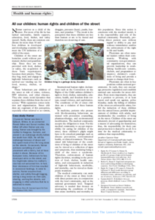International human rights declarations such as the Convention on the Rights of the Child address children’s rights to food, shelter, nationality, education, health, and freedom from torture, sexual violence, and exploitation. The conditions of life of street children are a violation of these human rights.
In medicine, patients who present with life-threatening behaviors are treated with prevention counseling, pharmacotherapy, and environmental modification. The medical community accepts the obligation to treat. For the medical community to accept responsibility for caring for children of the street, these children’s plight might have to fit a medical paradigm such as disease prevention, environmental health, or clinical treatment. The associated risk behaviors of the living conditions of "street children" can be viewed as a collection of signs and symptoms, thus rendering being a child of the street a syndrome. Therefore, enforcement of human rights doctrines, resulting in the provision of food, shelter, health care, safety, and consequently in reduction of high-risk behaviors, morbidity, and mortality, can be viewed as therapeutic treatment.
The medical community can assist children of the street at three levels: with direct patient care, in conjunction with the local community, and at the national government level. Targeted advocacy is needed that focuses on interrupting the conditions of living that create morbidity and mortality in this population. Since this action is consistent with the medical model, it is the responsibility and role of the medical community. Practically, providing direct patient care without regard to ability to pay and without intimidation enables the enforcement of the right to life and health.
©The Lancet

